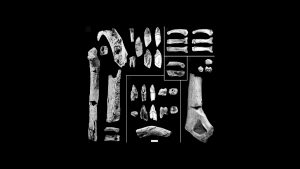
Image credit Yohannes Haile-Selassie
Ardipithecus kadabba is an early hominin species recovered from sediments in the Middle Awash Valley of Ethiopia dated to between 5.2 and 5.8 million years ago. This species was named and described based on a jaw fragment, a number of teeth, and some elements of the postcrania (body elements below the neck) including a toe bone. As one of the oldest species of human ancestors, Ar. kadabba pushed back the origin of the genus Ardipithecus (previously known from 4.5 to 4.3 million years ago) into the late Miocene Epoch (roughly 11.6 to 5.3 million years ago).
The recovered teeth of Ar. kadabba, particularly the canines, are noticeably more primitive (meaning they retain traits found in their ancestors, in this case represented by living apes) than later hominins such as Australopithecus afarensis and Australopithecus anamensis. For example, as in living apes, the upper and lower canines of Ar. kadabba are less incisor-like and pointy. However, as in all later hominins, neither its upper canine nor its lower third premolar shows any sign of functional canine honing—a function that all apes (particularly males) have in which they sharpen the upper canine by abrading the lingual side (tongue side) of the canine against the buccal side (the outer side) of the lower third premolars. The incisors (front teeth) are smaller than extant apes but are wider than those of australopiths and later hominins. Ar. kadabba canines are primitive in both size and shape—i.e., slightly smaller than female chimpanzee canines and more pointy than later hominins. In contrast, while the canines of Au. afarensis, Au. anamensis, and Ardipithecus ramidus are also smaller than those of female chimpanzees, exhibiting a shift to smaller canines found in all later hominins, they are also more incisor-like indicating that the function of the canines was changing to become part of the masticatory apparatus. The shape of the upper and lower canines in Ar. kadabba are derived (meaning it differs from the more “primitive” ancestral form) compared to those of female chimpanzees but more primitive than later hominins. The morphology of the Ar. kadabba upper canine is similar to its contemporaneous hominin species, Orrorin tugenensis. The molars and premolars of Ar. kadabba are similar in many general features with its presumed descendant, Ar. ramidus, including overall size, proportions, and wear patterns. Generally, the Ar. kadabba dentition retains some primitive features—e.g., relatively thinner dental enamel and a more asymmetrical lower third premolar (cheek teeth that lie between the canines and the molars) crown shape. The Ar. kadabba mandible is small yet broad, and the overall shape is similar to other early hominin species such as Sahelanthropus tchadensis and Ar. ramidus.
The known postcranial (the parts of the skeleton other than the skull) elements of Ar. kadabba are limited to fragmentary pieces of the forearm, two finger bones, a clavicle (collar bone) fragment, and a bone from the fourth toe. At least five individuals are represented among the 11 postcranial elements recovered. The forelimb (arm and hand) bones are fairly primitive, resembling living great apes. For example, the finger bones are relatively large with more strongly-built joint surfaces (where two bones meet to form a joint) than later hominins and the ulna (bone of the forearm closest to the body) is more curved and ape-like. Another primitive feature that distinguishes this species from more derived hominin species is found in the morphology of the elbow joint, which permits increased mobility—a characteristic of living apes and unlike the less mobile elbow of later hominins.
Ar. kadabba has been argued to have walked bipedally based on the characteristics of a single bone from the fourth toe, specifically the upward orientation of the joint surface closer to the heel. This feature is similar to the condition found not only in Au. Afarensis but also in our own species and other later hominins; living great apes, on the other hand, have more downwardly-tilted joint surfaces. The morphology of fourth toe has led some researchers to suggest Ar. kadabba walked bipedally and that this feature allowed this species to “toe off” (push off of the ground during bipedal walking, mostly with the big toe). However, as noted by other researchers, a similar joint shape occurs in nonhominin Miocene apes (e.g., Sivapithecus), which may or may not have walked bipedally along branches when in trees. In addition, the Ar. kadabba toe bone is dated to several hundred thousand years after other Ar. kadabba fossils and was found at a locality 16 km (10 miles) away from where all of the other specimens of the species have been found. This fact has caused some researchers to question the validity of grouping the toe bone with the rest of the Ar. kadabba fossils.
The evolutionary relationships between Ar. kadabba and other early hominin species are of great interest to paleoanthropologists. A more recent hominin taxon, Ar. ramidus, which is also found in the Middle Awash of Ethiopia, is argued by some researchers to be a direct descendant of Ar. kadabba because these two species share many features, such as relatively thin tooth enamel and larger canines. Some researchers further suggest that Ar. kadabba represents the earliest species in a single lineage of descent of eastern African hominin taxa, starting with Ar. kadabba to Ar. ramidus to Au. anamensis and ending with Au. afarensis. These species are all found in eastern Africa and some morphological trends, such as the reduction in canine size and premolar morphology, support this hypothesis, but the dates of Ar. ramidus and Au. anamensis cast some doubt on this explanation.
Ar. kadabba appears to have occupied a closed, densely-wooded habitat close to permanent sources of water (e.g., lakes and/or rivers) with swampy conditions and floodplain grasslands. This reconstruction is based on the fossil remains of nonhominin animals found in the same layers as the Ar. kadabba material and is considered by some researchers as evidence against the “savannah hypothesis,” which posits that bipedalism initially evolved in open grassland environments.